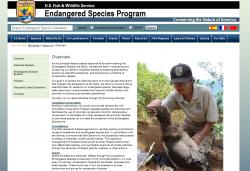Two Iowa Mussels Proposed As Endangered Species
January 19, 2011 | 2 min to read

The U.S. Fish and Wildlife Service has proposed Endangered Species Act protection for the sheepnose and the spectaclecase, two freshwater mussels found in river systems in the eastern half of the United States.
Sheepnose are currently found in Alabama, Illinois, Indiana, Iowa, Kentucky, Minnesota, Mississippi, Missouri, Ohio, Pennsylvania, Tennessee, Virginia, West Virginia, and Wisconsin. The sheepnose occurs in 24 streams, down from 77, a 69 percent decline. Very few of these populations are known to be reproducing.
The spectaclecase once occurred in at least 44 streams but now occurs in 19 streams, a 57 percent reduction in the number of occupied streams. Of the 19 remaining populations, six are represented by only one or two known specimens each. Spectaclecase mussels are currently found in Alabama, Arkansas, Illinois, Iowa, Kentucky, Minnesota, Missouri, Tennessee, Virginia, West Virginia, and Wisconsin.
Threats to both the sheepnose and the spectaclecase include loss and degradation of stream and river habitat due to impoundments, channelization, chemical contaminants, mining and sedimentation. Freshwater mussels require clean water; their decline often signals a decline in the water quality of the streams and rivers they inhabit.
The Service’s proposal, published January 19, 2011, in the Federal Register, initiates a public comment period during which the Service will gather information on the two mussels. The Service will make a final decision on whether to extend Endangered Species Act protection to the sheepnose and spectaclecase after evaluating all available information. If the two mussels are listed under the Endangered Species Act, the Service will work cooperatively with partners to conserve their habitats.
It is illegal under the ESA to kill, harm or otherwise “take” a listed species, or to posses, import, export or conduct interstate or international commerce without authorization from the Service. The ESA also requires all federal agencies to ensure actions they authorize, fund, or undertake do not jeopardize the existence of listed species.
Comments may be submitted using one of the following methods:
• Federal eRulemaking Portal: http://www.regulations.gov. Follow the instructions for submitting comments on docket number FWS-R3-ES-2010-0050.
• U.S. mail or hand-delivery: Public Comments Processing, Attn: FWS-R3-ES-2010-0050; Division of Policy and Directives Management; U.S. Fish and Wildlife Service; 4401 N. Fairfax Drive, Suite 222; Arlington, VA 22203.
In particular, the Service is looking for information on distribution, status, population size or trends; life history; and threats to these species. The comment period ends on March 21, 2011.
Source: U.S. Fish and Wildlife Service
